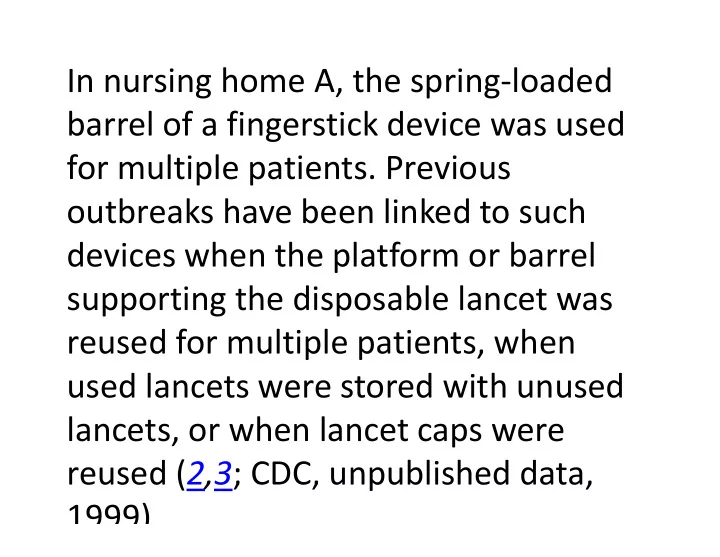

In nursing home A, the spring ‐ loaded barrel of a fingerstick device was used for multiple patients. Previous outbreaks have been linked to such devices when the platform or barrel supporting the disposable lancet was reused for multiple patients, when used lancets were stored with unused lancets, or when lancet caps were reused ( 2,3 ; CDC, unpublished data, 1999)
• In nursing home C, as with other recent outbreaks ( 8 ; CDC, unpublished data, 2002), transmission of HBV among residents with diabetes occurred despite use of single ‐ use fingerstick devices or insulin medication vials that were dedicated for individual patient use.
In these settings, glucose monitors, insulin vials, or other surfaces contaminated with blood from an HBV ‐ infected person might have resulted in transfer of infectious virus to a health ‐ care worker's gloves and to the fingerstick wound or subcutaneous injection site of a susceptible resident.
Similar indirect transmission of HBV in health ‐ care settings through contaminated environmental surfaces or inadequately disinfected equipment has been reported with other health ‐ care procedures, such as dialysis ( 6,9 ). HBV is stable at ambient temperatures; infected patients, who often lack clinical symptoms of hepatitis, can have high concentrations of HBV in their blood or body fluids ( 6 ).
To prevent patient ‐ to ‐ patient transmission of infections through cross ‐ contamination, health ‐ care providers should avoid carrying supplies from resident to resident and avoid sharing devices, including glucometers, among residents.
Actions • Best practice: one glucometer per patient/resident • Clean and disinfect glucometer between use on different patients/residents • Use manufacturer’s recommendation if it is a sound, scientific recommendation • Use a disinfectant that meets the requirements for decontaminating blood – Hypochlorite based – Tuberculocidal – OR – EPA registered kill data against HIV/HBV
Recommend
More recommend